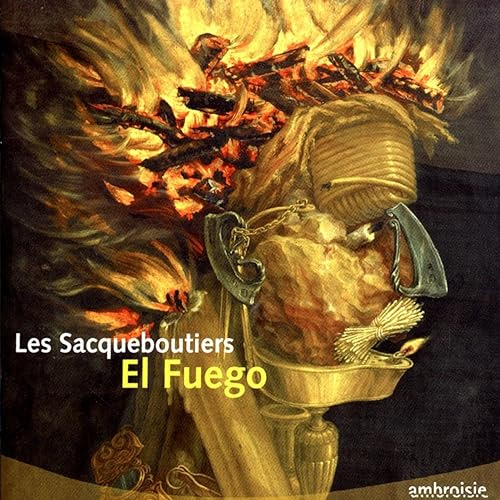Program: #20-19 Air Date: Apr 27, 2020
To listen to this show, you must first LOG IN. If you have already logged in, but you are still seeing this message, please SUBSCRIBE or UPGRADE your subscriber level today.
NOTE: All of the music on this program is from the ensemble Les Sacqueboutiers de Toulouse. The wonderful French ensemble takes us on a trip first to Golden Age Spain, then on to the New World, and finally back home for a celebration of Rabelais.
Since their founding in 1976, Les Sacqueboutiers have dedicated themselves to rediscovering the practice of ancient brass and the vast repertoire of the Renaissance , the golden age of their instruments. They have established themselves as one of the most imaginative early music ensembles. The search for musical excellence remains the driving force of their work. Selected as Ensemble of the Year at the Victoires de la Musique Classique 2008 , they collaborated with the most prestigious ensembles to perform repertoires ranging from the Renaissance to Mozart: Hesperion XXI , The Arts Florissants , The Royal Chapel , The Great Stable and the Chambre du Roy, the vocal ensemble Clément Janequin.
The Sacqueboutiers are not limited to the repertoire of the Renaissance. Their creativity leads them to design shows that combine ancient music with other artistic universes : contemporary music, dance, the world of puppetry, jazz, literature, ethnomusicology.
For more information: https://www.les-sacqueboutiers.com/.
I. Les Sacqueboutiers: El Fuego. Ambroisie CD AM 129.

The level of inspiration in terms of arranging is slightly inconsistent among the support material; even though these bridging pieces are quite short in most cases, it is in these tracks that the program seems to get a little bogged down. However, the realizations of the works of Flecha are outstanding, palpitating with rhythm, sung with gusto and enthusiasm, and almost operatically varied in terms of instrumental color. This is so well done that one wonders what marvels Les Sacqueboutiers would be able to wring out of madrigal comedies, such as those by Adriano Banchieri. Les Sacqueboutiers' treatment of Flecha's La Justa (The Tournament) is a real standout, with the attention paid to its highly flexible rhythms and use of tastefully handled percussion throughout. La Guerra (The War) is treated as the mother of all battle pieces, with ominous, martial percussion sounding well before the piece begins. La Guerra is such an elaborate and well thought out realization that it almost seems like a mini-opera in itself. While Ambroisie's El Fuego may not be wall-to-wall in its absolute sense, the best of it more than makes up for any momentum lost, and this should well satisfy those who take an interest in the typically salty and spirited popular side of the Renaissance coin.
| 1 | Mateo Flecha* | El Fuego | 13:44 |
| 2 | Correa de Arauxo* | Tiento De 6º Tono | 6:13 |
| 3 | Mateo Flecha* | La Justa | 13:59 |
| 4 | Juan Vásquez* | Por Vida De Mis Ojos | 2:24 |
| 5 | Juan Vásquez* | En La Fuente Del Rosel | 1:14 |
| 6 | Sebastián Aguilera De Heredia | Tiento De Batalla De 8º Tono | 4:09 |
| 7 | Mateo Flecha* | La Guerra | 10:32 |
| 8 | Juan Vásquez* | ¿Con Qué La Lavaré? | 5:02 |
| 9 | Mateo Flecha* | La Negrina | 8:08 |
II. Voyage musical en Nouvelle-Espagne. Flora CD FLO 4519.

to give an account of this "shock of the conquest" the texts found alternate the points of view: sometimes borrowed from conquistadores companions of Cortes, they are also drawn from the Indian chronicles which told the arrival of the Spaniards and the incomprehension which in has resulted.
This encounter between two worlds has also been musical, as evidenced by the program of this concert which features works composed and performed in New Spain in the 16th century and resulting from Mesoamerican interbreeding. This is the case of the pieces of Gaspar Fernandes (v. 1565-1629), a composer of Portuguese origin. We must also note the pièces extracted from the manuscripts of Santa Eulalia. These sources are invaluable testimonies of the daily musical practice of Guatemalan rurality. Despite the great social and geographical distance that separates them from the production of a Gaspar Fernandes cathedral or a Garcia de Zéspedes, these manuscripts show that deep in the mountains of Central America, local musicians created original works which reflect at the same time the lessons of their Spanish masters and a sensitivity rooted in pre-Columbian culture.
III. Rabelais: Fay ce que vouldras (with the Ensemble Clement Janequin/Dominique Visse). Flora CD 2410.

Composer Info
Mateo Flecha El Viejo (1481–1553), Francisco Correa De Arauxo (1584–1654), Juan Vasquez, Sebastián Aguilera De Heredia (1561–1627), Santa Eulalia, Gaspar Fernandes (v. 1565-1629), José Gimenez, Garcia de Zépedes, Santiago de Murcia, Juan Perez Bocanegra, Juan Aranes, Josquin Des Prez (ca.1455-1521), Claude Le Jeune (1528-1600), Clément Janequin (1485-1558), Orlande de Lassus (1532-1594), Claudin de Sermisy (1490-1562)
CD Info
Ambroisie CD AM 129, Flora CD FLO 4519, Flora CD 2410.